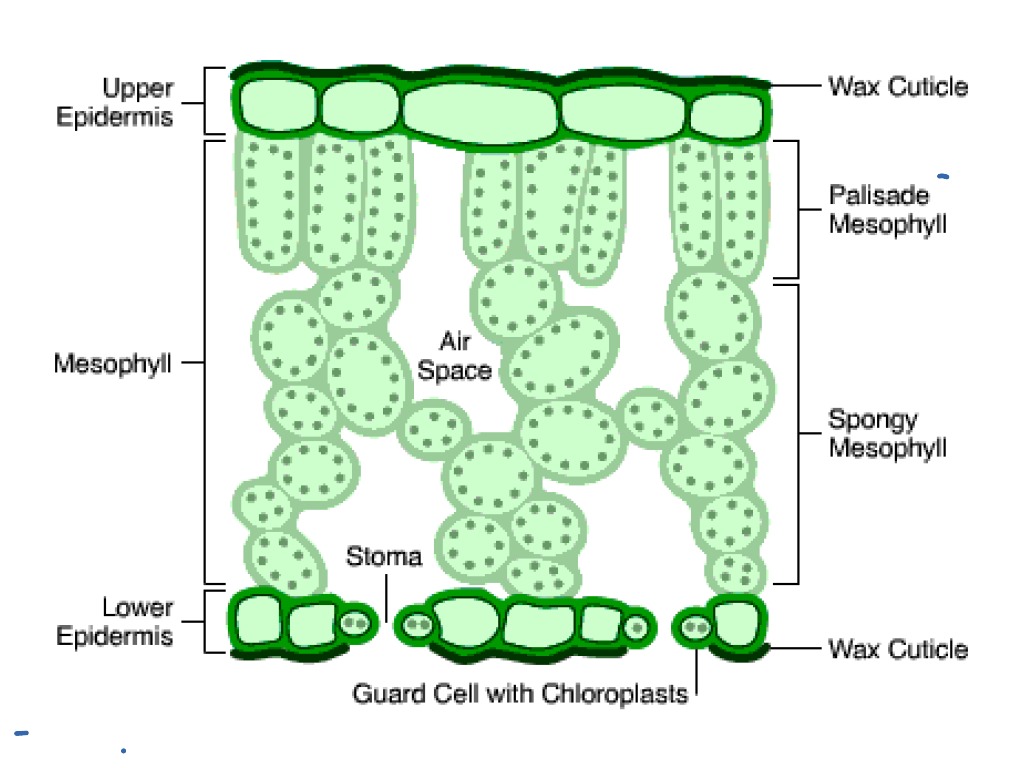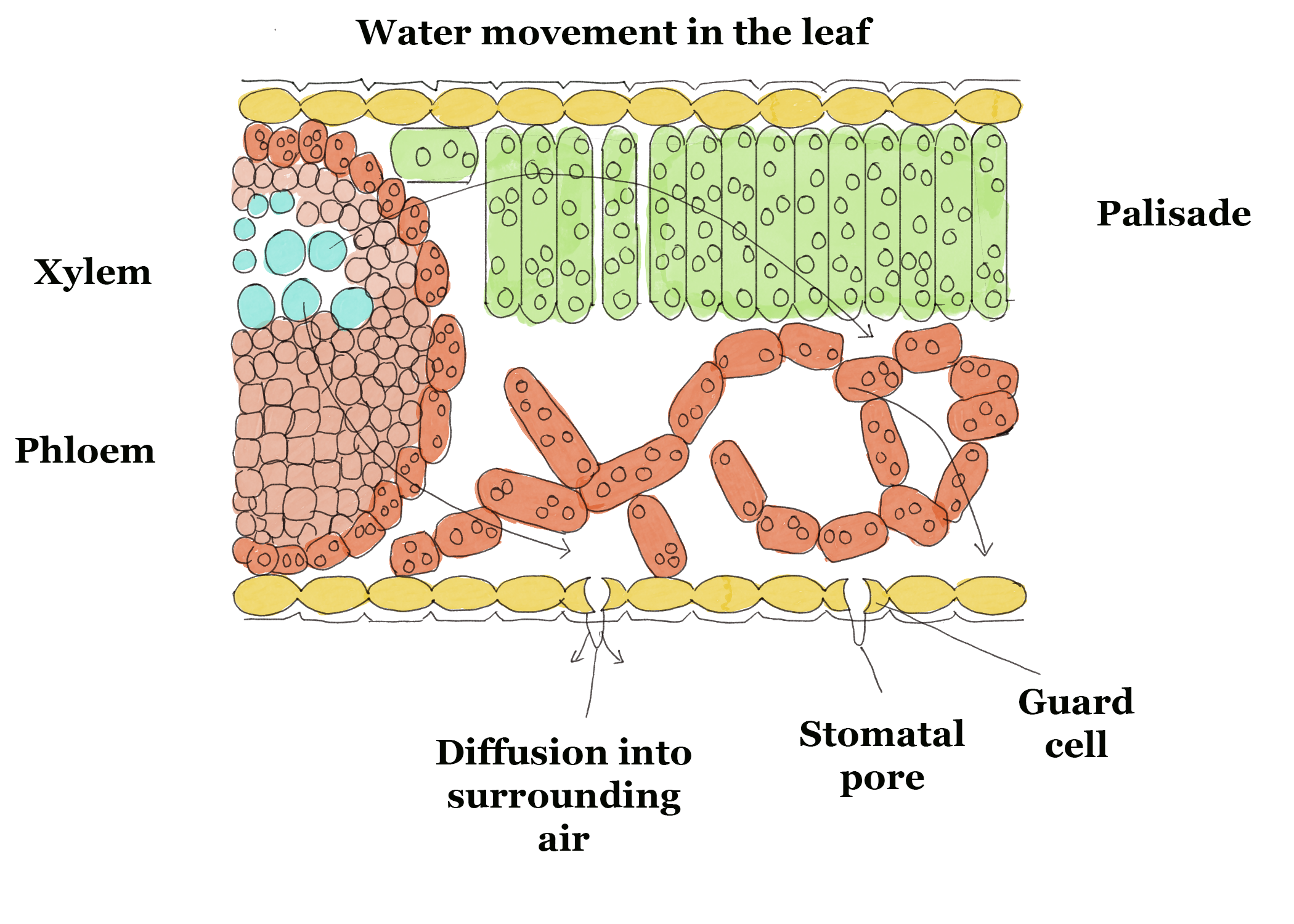
Specialized Cells of the Leaf System Let's Talk Science
Labeled diagram of plant cell. The typical characteristics that define the plant cell include cellulose, hemicellulose and pectin, plastids which play a major role in photosynthesis and storage of starch, large vacuoles responsible for regulating the cell turgor pressure. They also have a very unique cell division process whereby there is the.

Labeled diagram of a plant palisade cell where photosynthesis takes place Stock Photo Alamy
The cell wall tends to give plant cells a boxy, rigid structure. Figure 3.8.1 3.8. 1: Elodea leaf cells. The most obvious of the membrane-bound organelles you will see are the chloroplasts. These numerous, green, disc-like structures are responsible for doing photosynthesis, making food for the plant.

Leaf Structure photo Botany, Teaching biology, Biology
A leaf cell, by definition, is any cell found within a leaf. However, there are many different kinds of leaf cell, and each plays an integral role in the overall function of the leaf and the plant itself. A single leaf cell may be designed to simply photosynthesize, or create sugars from the energy in light.

Leaf & Chloroplast Structure photo Biology plants, Plant science, Teaching biology
They are attached by a continuous vascular system to the rest of the plant so that free exchange of nutrients, water, and end products of photosynthesis (oxygen and carbohydrates in particular) can be carried to its various parts. Leaves are initiated in the apical bud (growing tip of a stem) along with the tissues of the stem itself.

Photosynthates Biology I
Like the stem, the leaf contains vascular bundles composed of xylem and phloem (Figure 3.4.2.6 − 7 3.4.2. 6 − 7 ). When a typical stem vascular bundle (which has xylem internal to the phloem) enters the leaf, xylem usually faces upwards, whereas phloem faces downwards. The conducting cells of the xylem (tracheids and vessel elements.

SC.912.L.14.7 Plant Structure to Dr. Suris Science Class!
March 22, 2022 6.35 How does this align with my curriculum? Province/Territory Share on: Learn about the structure and function of the cells in leaves. Leaves are essential to life on earth. They can be tiny, like the leaves of the common water fern ( Azolla filiculoides), which are just one millimetre in length.

PPT Chapter 32 Leaf Structure and Function PowerPoint Presentation, free download ID1742285
Leaves are a part of the plant shoot system, which also includes stems and flowers . Key Takeaways Plant leaves are very important structures as they help to maintain life on earth by generating food (sugars) via photosynthesis. Leaves can have different shapes and sizes.

Leaf Structure and Photosynthesis YouTube
How do they work? An microphotograph of a stoma shows the two guard cells which regulate its opening and closure to limit water loss, excrete oxygen, and absorb carbon dioxide. The openings or pores in stomata are formed by two specialized sclerenchymal cells, the guard cells ( Figure above ).

Cross Section Of A Leaf Diagram Labeled Wiringopedia
This type of plant is called a mesophyte (meso- meaning middle, -phyte meaning plant), preferring moderate climatic conditions. Figure 9.3. 1: Mesophytic Leaf. The outer layer of cells on both the upper and lower surface of the leaf is the epidermis. Can you find any pores (gaps) in the epidermis?

Labeled Diagram Of A Leaf hubpages
Label the leaf Quiz Key points The leaf is one of the most important organs of a plant. Leaves produce food for the plant through a process called photosynthesis. The leaves of different.

dicot leaf anatomy
Leaves are the main sites for photosynthesis: the process by which plants synthesize food. Most leaves are usually green, due to the presence of chlorophyll in the leaf cells. However, some leaves may have different colors, caused by other plant pigments that mask the green chlorophyll. The thickness, shape, and size of leaves are adapted to.

Pinus Leaf Cross Section Labeled
The air space found between the spongy parenchyma cells allows gaseous exchange between the leaf and the outside atmosphere through the stomata. In aquatic plants, the intercellular spaces in the spongy parenchyma help the leaf float. Both layers of the mesophyll contain many chloroplasts. Figure 30.10. 1: Mesophyll: (a) (top) The central.

Leaf Structure, Types, Functions GCSE Biology Revision
GCSE WJEC Structure of plants - WJEC Leaf structure Plants adapt in order to efficiently collect raw materials required for photosynthesis. These raw materials must be transported through the.

32 Label A Leaf Diagram Labels 2021
Key points: All cells have a cell membrane that separates the inside and the outside of the cell, and controls what goes in and comes out. The cell membrane surrounds a cell's cytoplasm, which is a jelly-like substance containing the cell's parts. Cells contain parts called organelles. Each organelle carries out a specific function in the cell.

Plant Cell Labelled Diagram Ideas of Europedias
Leaf Structure Under the Microscope ** Preparation, Requirements and Observations Introduction. Like any other multicellular living thing, leaf structure is made up of layers of cells. Viewing the leaf under the microscope shows different types of cells that serve various functions. Using a microscope, it's possible to view and identify these cells and how they are arranged (epidermal cells.

Internal Structure of a Leaf DanicateMullen
Figure \(\PageIndex{12}\): This image shows the same Elodea leaf cells again, this time with the cell wall, cell membrane, and tonoplast of one of the cells labeled. The cell walls are visible as thicker lines between the cells. The plasma membrane and tonoplast locations must be inferred. The plasma membrane is pushed against the cell wall.